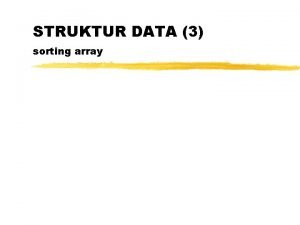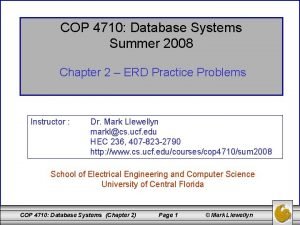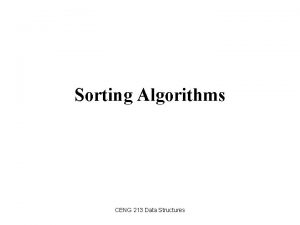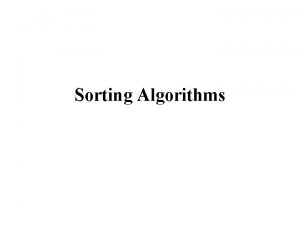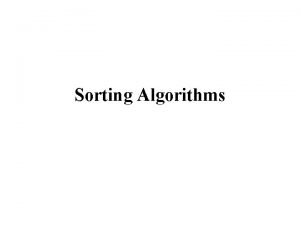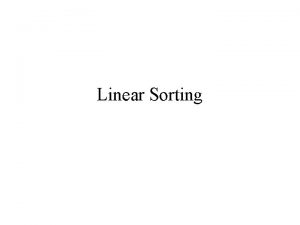COP 3530 Data Structures Sorting Dr Ron Eaglin





















- Slides: 21

COP 3530 - Data Structures Sorting Dr. Ron Eaglin

Objectives • Understand key elements of sorting algorithms • Select appropriate sorting algorithm for situation • Apply sorting algorithms to data structures

Sorting • Systematically arrange items into groups or in a specific order. • A sorting algorithm puts elements in a list in a specific order • Some algorithms are old, but newer algorithms have been introduced (Timsort, 2002) (Library Sort, 2006)

Evaluating Sorting • Computational Complexity (as expressed by Big O) • Computational Complexity of swaps • Memory use • Stability • Comparison operators

Sorting Stability • IF two items to be sorted are equivalent, their relative order will be preserved. • Not a problem if all items are unique • Sometimes a secondary comparison is used as a tie-breaker

Algorithms used in sorting - Swap function swap(a, b) { var temp = a; a = b; b = temp; } Swaps actual variables

Singly Linked List Sort A B B A NULL a. next = b. next; b. next = a;

Single Linked List Swap A A B C Swap B and C C B NULL var temp = a. next; // Node B a. next = b. next; // Node C b. next = c. next; // NULL c. next = temp; // Node B

Singly Linked List Swap A A B C Swap B and C C B NULL function swap(a) { var b = a. next; var c = a. next; var temp = a. next; // Node B a. next = b. next; // Node C b. next = c. next; // NULL c. next = temp; // Node B } Don’t forget to check to see if next is not null

A A Swap B and C B C D C A. next = B B. next = C C. next = D B D A. next = C B. next = D C. next = B

A B C D A. next = B B. next = C C. next = D A. next = C B. next = D C. next = B function swap(A) { var B= A. next; var C = B. next; var D = C. next; A. next = C; B. next = D; C. next = B; } Can be done many ways – simplest conceptual implementation A C B D

Swapping • Alternately the contents of the node can be swapped. • Implementation for singly linked list, also doubly linked lists or other architectures. • Swap is key to some algorithms.

Swapping Contents function swap( a, b) { var c = a. value; a. value = b. value; b. value = c; } Much simpler conceptually than switching pointers – but… if other properties are attached to node – will be left behind.

Bubble Sort • Simplest of sorting algorithms • O(n^2) • Uses swap set swapped Boolean to false iterate through list if node. value > node. next. value swap nodes set swapped Boolean to true Repeat until no swaps made

Another look at Swap A B C D E F H Suppose we want to swap B and F A B C D E F H We would need to change pointers a. next and f. next We need a. next, b, e. next, and f to make the swap efficiently

Quick. Sort Algorithm • Average Case Complexity O(n log n) and In-Place algorithm • Steps • 1. Pick a Pivot from the array • 2. Rearrange array so all elements < pivot are before, all elements > are after • 3. Re-apply steps 1 and 2 recursively on the sub-arrays. • Plenty of tutorials online – follow step-by-step

Merge Sort • O( n log n) worst case complexity, NOT In-place algorithm • Steps • 1. Divide the unsorted list into n sublists • 2. Merge sorted sublists into new sorted sublists • Relies on efficient Merge algorithm

Merge Sort Example List: Sublists: 3– 4– 2– 1– 7– 5– 8– 9– 0– 6 3– 4 2 1– 7 5– 8– 9 0– 6 Merge: 2– 3– 4 Merge: 1– 2– 3– 4– 5– 7– 8– 9 Merge: 0– 1– 2– 3– 4– 5– 6– 7– 8– 9 1– 5– 7– 8– 9 0– 6

Efficiency and Performance • Algorithm Worst Case and Average performance is important • Efficiency of sub-algorithms are important (swap, merge) • Differences for different structures

Sorting Algorithms • Full outline on Wikipedia • https: //en. wikipedia. org/wiki/Sorting_algorithm • Best, average, and worst case complexity • Memory requirements • Stable • Limitations for various structures

Objectives • Understand key elements of sorting algorithms • Select appropriate sorting algorithm for situation • Apply sorting algorithms to data structures
 Cop 3530
Cop 3530 Good cop bad cop interrogation
Good cop bad cop interrogation Cop 1 cop 2
Cop 1 cop 2 Internal vs external sorting
Internal vs external sorting Gtr 3530
Gtr 3530 Csae 3530
Csae 3530 How are the whale flipper and the human arm different
How are the whale flipper and the human arm different Tujuan pengurutan adalah
Tujuan pengurutan adalah Restricting and sorting data in oracle
Restricting and sorting data in oracle Tessy badriyah
Tessy badriyah Program pengurutan sorting dan pencarian searching data
Program pengurutan sorting dan pencarian searching data Exchange sort adalah
Exchange sort adalah Multipurpose refrigeration systems with a single compressor
Multipurpose refrigeration systems with a single compressor Air refrigeration system
Air refrigeration system Audit cop
Audit cop Cop of heat pump and refrigerator
Cop of heat pump and refrigerator üçgen prizmaya benzer eşyalar
üçgen prizmaya benzer eşyalar Pollycop
Pollycop Cop 4910
Cop 4910 Cop 4710
Cop 4710 Cop 4710 ucf
Cop 4710 ucf Cop 3402
Cop 3402











